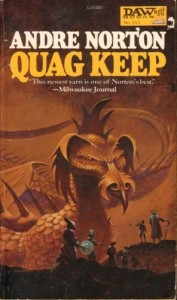 From Andre Norton’s silly D&D novel, Quag Keep:
From Andre Norton’s silly D&D novel, Quag Keep:
Memory once more moved in Milo’s mind, opening grudgingly another door. It was a gar-eagle-the greatest of all winged creatures (save, of course, a dragon) that his world knew. The very beating of those wings churned up snow as the bird descended. And when it came to perch at last on a rock a little farther ahead, closed its fifteen-foot wings, and twisted its head downward toward the elf-over whom it would have towered another head’s length had they been meeting on level ground-even Naile pushed back a fraction.
Many fantasy worlds provide their own version of a roc, from Tolkien’s giant eagle to John Norman’s tarn from the Gor series which Arneson used in his own campaign. I’m not sure where the gar-eagle came from: was it a reference, conscious or otherwise, to John Norman’s Gor? or just a nonsense fantasy world?
Odd note: in looking for prior references to “gar”, I found this veteran’s organization, whose symbol is an eagle.
Milo did not need the faint, musty smell of corruption that wafted toward them from that crew to know that these were liches, the Undead. Their body armor was the same color as the dust that had been their outward tomb for so long. They even wore masks of metal, having but holes for eyes and nostrils, which hung from their helmets, covering their faces. The masks had been wrought in the form of fierce scowls, and tufts of metal, spun as fine as hairs, bearded their chins to fan outward over their mail corselets. They poured up from the hold, swords in hand-strange swords curved as to blade-which they swung with a will. And the Undead could not die. Milo, as he reached the surface of the deck, saw Naileboar savage one of the Undead with his tusks, breaking armor as brittle as the shell of a long-dead beetle, in fact breaking the liche almost in two. But its feet continued to stand and the torso, as it fell, still aimed a blow at its attacker. “ALL-LL-VAR!”
In this passage, “lich” is used as a general term for undead. In fact, these liches sound more like skeletons or zombies – undead fighters, not undead wizards.
If Andre Norton encountered, or heard of, a spell-casting lich in her dungeon crawl, there’s actually no reason that she would have believed that the creature’s spells were an integral part of its lichiness. After all, before D&D, “lich” just means “corpse”. But for me, decades of D&D tradition and fantasy imitation have made “lich” synonymous with “skeleton spellcaster”, so this passage just seems weird.
There were women secrets that even the wizards could not fathom. Milo had heard tell of them. He shook his head as if to loosen a pall of dust from his mind, as he had in part from his body. Women magic-cold. Moon magic. . . . All men knew that women had a tie with the moon which was knit into their bodies. What she wrought here might be as alien to him as the thoughts and desires of a dragon — or a liche — if the dead-alive had thoughts and not just hungers and the will of Chaos to animate them. Yet Milo could not turn away — for still that trilling enticed, drew him. Then she spoke, though she did not turn her head.
This “moon magic” stuff reminds me of the back of Sign of the Labrys, another book by a female Appendix N author:

There was life also, for he started once and nearly spun off into the dust, as the sound of shrill and loud croaking made him think, with a shiver he could not entirely subdue, of that horror tale told about the Temple of the Frog and the unnatural creatures bred and nurtured therein to deliver the death stroke against any who invaded that hidden land. That, too, occupied the heart of a swamp, holding secrets no man of the outer world could more than guess.
Temple of the Frog! That’s from the 1975 Blackmoor supplement. Just how much did Andre Norton know about D&D? Did she have the rulebook and all the supplements? Are her lore changes made in ignorance, or was her novel set in a consciously house-ruled version of D&D? So confusing.
Tags: everybook







Another guess on the gar-eagle – it might be a variation of the gyrfalcon (also spelled gerfalcon), which is notably the largest of the falcon species. I’ll just leave this link here, and you can decide if it’s a likely parallel.
http://en.wikipedia.org/wiki/Gyrfalcon
Or did she make up some shit she thought would be fun?
If she was going for a fun tone she missed the mark virtually everywhere else in this book.